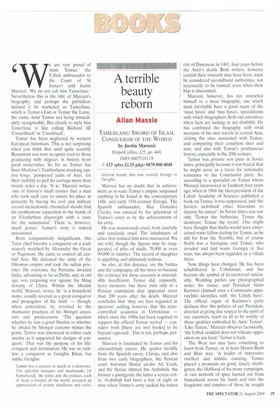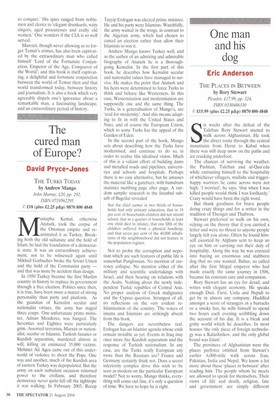A terrible beauty reborn
Allan Massie
TAMERLANE: SWORD OF ISLAM, CONQUEROR OF THE WORLD by Justin Marozzi HarperCollins, £25, pp. 449,
ISBN 000711611X £23 (plus £2.25 p&p) 0870 800 4848 ‘ e are very proud of Amir Temur,' the Uzbek ambassador to the Court of St James's told Justin Marozzi, 'We do not call him Tamerlane.' Nevertheless this is the title of Marozzi's biography, and perhaps the publishers insisted it be marketed as Tamerlane, which is Temur-i-Lan or Temur the Lame, the name Amir Temur not being immediately recognisable. But clearly to style him Tamerlane is like calling Richard III `Crouchback' or `Crookback'.
Temur has been neglected by western European historians. This is not surprising when you think that until quite recently Byzantium was terra incognita even to those graduating with degrees in history from good universities. So for us Temur has been Marlowe's Tamburlaine mocking captive kings, 'pampered jades of Asia', for their inability to pull his carriage more than twenty miles a day. 'It is,' Marozzi writes, 'one of history's small ironies that a man who took such care to ensure his place in posterity by having his civil and military record meticulously chronicled should find his posthumous reputation in the hands of an Elizabethan playwright with a taste for the sensational.' There is, however, much justice: Temur's story is indeed sensational.
Born comparatively insignificant, this Tatar chief become a conqueror on a scale scarcely matched by Alexander the Great or Napoleon. He came to control all central Asia. He defeated the army of the Ottoman empire and took the sultan prisoner. He overcame• the Persians, invaded India, advancing as far as Delhi, and, in old age, was preparing war against the Ming dynasty of China. Within the Muslim world, Marozzi, writes, he 'is a household name, usually revered as a great conqueror and propagator of the faith' — though, when convenient, he reverted to the shamanist practices of his Mongol ancestors and predecessors. 'The question whether he was a good Muslim or whether he abided by Mongol customs misses the point. Temur was interested in either code insofar as it supported his designs of conquest.' That was the purpose of his life: conquest and domination. He was as ruthless a conqueror as Genghis Khan, but unlike Genghis
Temur was a creator as much as a destroyer. The splendid mosques and madrassahs [of Samarkand], the parks and the palaces, each of them a wonder of the world, revealed an appreciation of artistic excellence and archi tectural beauty that was entirely foreign to Genghis.
Marozzi has no doubt that in achievement as in scale Temur's empire surpassed anything to be found in the contemporary 14thand early 15th-century Europe. The Spanish ambassador, Ruy Gonzalez Clavijo, was amazed by the splendour of Temur's court as by the achievements of his army.
He was monstrously cruel, both carefully and carelessly cruel. The inhabitants of cities that resisted him were massacred. We are told, though the figures may be exaggerated, of piles of skulls. 70,000 or even 90,000 in number. The record of slaughter is appalling, and ultimately tedious.
So also, at this distance, are the battles and the campaigns, all the more so because the evidence for these accounts is unavoidably insufficient. Temur did, reputedly, leave memoirs, but these exist only in a Persian translation that appeared more than 200 years after his death. Marozzi concludes that 'they are best regarded as specious', adding, however, that 'the statecontrolled academia in Uzbekistan — which since the 1990s has been required to support the official Temur revival — considers both [there are two books] to be beyond reproach'. This is not, perhaps, persuasive.
Marozzi is fascinated by Temur and his extraordinary career. He quotes lavishly from the Spanish envoy, Clavijo, and also from two early biographers, the Persian court historian Sharaf ad-din Ali Yazdi, and the Syrian Ahmed ibn Arabshah, the former a panegyrist, the latter a severe critic. Arabshah had been a boy of eight or nine when Temur's army sacked his native city of Damascus in 1401, four years before the Amir's death. Both writers, however careful their research may have been, must be considered secondhand authorities, not necessarily to be trusted, even when their bias is discounted.
Marozzi, however, has not restricted himself to a mere biography, one which must inevitably have a good many of the 'must haves' and 'may haves', speculations with which biographers flesh out narratives when facts are lacking or are doubtful. He has combined the biography with vivid accounts of his own travels in central Asia, visiting the sites associated with Temur, and comparing their condition then and now, and also with Temur's posthumous history, especially in the 20th century.
Temur was persona non grata in Soviet times. principally because it was feared that he might serve as a focus for nationalist resistance to the Communist party. So, according to a specialist on Temur whom Marozzi interviewed in Tashkent four years ago, when in 1968 the then president of the Uzbek Academy of Sciences published a book on Temur, it was suppressed, and 'the Soviets mobilised other historians to destroy his career'. In Soviet times you saw only 'Temur the barbarian, Temur the destroyer, Temur the tyrant'. One might have thought that Stalin would have entertained some fellow-feeling for Temur, as he did for Ivan the Terrible, but of course Stalin was a Georgian, and Temur, who invaded and laid waste Georgia in five wars, has always been regarded as a villain there.
Now things have changed. He has been rehabilitated in Uzbekistan, and has become the symbol of its recovered nationality. Wedding parties are photographed under his statue, and President Islam Karimov (himself once a Communist apparatchik) identifies with 'the Uzbek hero'. The official organ of Karimov's party declares that 'the policies of our President, directed at giving due respect to the spirit of our ancestors, teach us all to be worthy of those qualities embodied by Amir Temur'. 'Like Temur,' Marozzi observes laconically, 'the Uzbek resident does not tolerate opposition on any level.' Temur is back.
The West too may have something to learn from Temur, or at least Messrs Bush and Blair may. 'A leader of impressive intellect and infinite cunning, Temur placed a premium on good, timely intelligence, the lifeblood of his many campaigns. A vast network of spies fanned out from Samarkand across his lands and into the kingdoms and empires of those he sought to conquer.' His spies ranged from noblemen and clerics to 'elegant drunkards, witty singers, aged procuresses and crafty old women.' One wonders if the CIA is so well served.
Marozzi, though never allowing us to forget Temur's crimes, has also been captivated by the extraordinary man who called himself 'Lord of the Fortunate Conjunction, Emperor of the Age, Conqueror of the World'; and this book is itself captivating, a delightful and fortunate conjunction between the world of Temur then and that world transformed today, between history and journalism. It is also a book which very agreeably dispels one's ignorance about a remarkable man, a fascinating landscape, and an extraordinary period of history.



























































 Previous page
Previous page